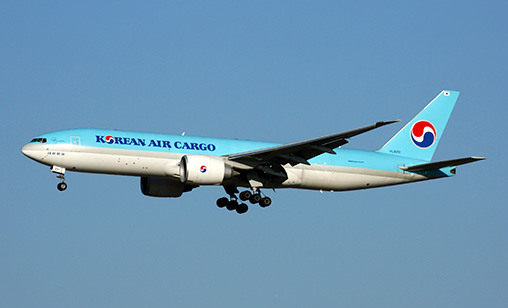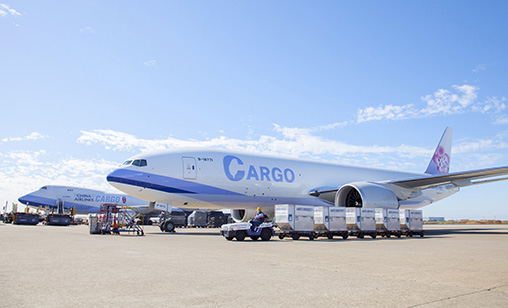News Backgrounder
Air cargo bonanza promises profits beyond the pandemic
It is hardly news air cargo is the shining light of Asia-Pacific aviation amid the gloom of the pandemic. Statistics indicate the sector’s recent growth will endure beyond COVID-19 requiring the region’s airlines to expand their cargo divisions to keep pace with demand. Associate editor and chief correspondent Tom Ballantyne, reports.
August 1st 2021
Air freight traffic is solidly back to pre-pandemic levels. And there is more good news on the horizon. Read More » The International Air Transport Association (IATA) has reported air cargo is now much more competitive with ocean shipping. At press time, air freight was only six times more expensive than ocean transport compared with 12 times more costly pre-COVID-19.
At the same time, rapid growth in e-commerce, accelerated by stay-at-home orders, lockdowns and demand for transport of temperature sensitive drugs, chemicals and medicines are propelling air freight growth to bigger profits. Air cargo has become crucial to moving medical supplies around the world and that growth is expected to continue after the recovery because online retailing and express home deliveries have become part of daily life.
 |
For example, in the first half of 2021 Chinese commercial airlines carried 3.74 million metric tonnes of cargo and mail, an increase of 6.4% over the same period in 2019. International cargo flights increased by 7.8%.
Global air cargo is forecast to increase by 4.9% annually, to around $144 billion, by 2027. But given market indicators, the projections may be conservative. Differing predictions aside, it is generally agreed the Asia-Pacific will remain the fastest growing air cargo market in the world, rising in excess of 5% a year and achieving a value of more than $60 billion by 2027.
While there continues to be a cargo capacity shortfall because of lost belly space from a depleted passenger jet fleet, airlines are lifting cargo capacity. The passenger-to-cargo conversion business is booming. Cargo Facts Consulting has reported active and planned passenger-to-freighter conversion sites across all jet aircraft types have increased to 25 worldwide.
The cargo sector’s latest statistics, for June this year, reveal a continued upward trend even though comparisons between 2020 and 2021 are distorted “by the extraordinary impact of COVID-19”, IATA said. But global demand in June this year was up on 2019. Global demand this year, it reported, increased 9.9% compared with June 2019, the 14th consecutive month of improvement. And while the pace of growth did slow slightly in June, air cargo outperformed global goods trade for the sixth consecutive month.
In June, Asia-Pacific airlines reported demand for international air cargo increased 3.8%, a decrease from the previous month (5.3%) due to a slight slowdown in growth in several large trade routes such as Within Asia. International capacity remained constrained in the region, down 16.9% versus May 2019. But as was the case two months earlier, the region’s airlines reported their highest international load factor at 75.2%.
IATA said underlying economic conditions and favourable supply chain dynamics remain supportive for air cargo, adding Purchasing Managers Indices - leading indicators of air cargo demand - show business confidence, manufacturing output and new export orders are growing at a rapid pace in most economies.
 |
“Propelled by strong economic growth in trade and manufacturing, demand for air cargo is 9.4% above pre-crisis levels. As economies unlock, we can expect a shift in consumption from goods to services. This could slow growth for cargo in general, but improved competitiveness compared to sea shipping should continue to make air cargo a bright spot for airlines while passenger demand struggles with continued border closures and travel restrictions,” said IATA director general, Willie Walsh.
Association of Asia Pacific Airlines (AAPA) director general, Subhas Menon, echoed these sentiments and said air cargo volumes carried by Asia-Pacific airlines have largely recovered to pre-pandemic volumes in response to strong demand. “This contrasts starkly with the depressed state of international passenger traffic, which has remained largely stagnant with no improvements in over a year,” he said.
In May, international air cargo demand in Asia measured in freight tonne kilometres (FTK) saw 23.1% year-on-year growth compared with a year earlier, significantly outpacing the 3.6% increase in offered freight capacity, as belly hold space remained constrained due to limited commercial passenger operations. As a result, the average international freight load factor rose by 11.7 percentage points to 73.7%.
Some cargo operators are doing even better. Singapore Airlines Cargo, for example, saw its cargo load factor in June rise to 87.6%, which was 5.1 percentage points higher year-on-year, as cargo traffic rose by 52.0% on the back of a capacity expansion of 43.3%.
Cathay Pacific Airways has reported its freight load factor increased by 5.6 percentage points to 80.6% and capacity, or available freight tonne kilometres (AFTKs), was up by 2.7% year-on-year, although down 44.4% versus June 2019. “With quarantine restrictions easing following the high uptake of vaccination among our aircrew, we were able to further reinstate our freighter capacity, especially on our long-haul routes.
“We also were able to mount considerably more cargo-only passenger flights compared with the previous month, especially on short-haul routes, to meet the reasonably strong regional demand,” the airline said.
“Regarding cargo, we are cautiously optimistic that overall demand will be strong for the remainder of the year. Gradual resumption of passenger services will provide us with greater belly capacity and should coincide with the usual cargo peak season.
 |
“To provide additional lift we are converting two more of our B777 passenger aircraft into cargo-only ‘preighters’ by removing seats from the Economy Class cabin, bringing our total to six ‘preighters’. These aircraft will provide support to our general cargo and post shipments around Asia.”
In all of this, the shift from seaborne freight to air cargo is very significant for the future of the sector. Interestingly, it has been acknowledged by the world’s biggest shipping company, Denmark-based Maersk, which has subsidiaries and offices in 130 countries and around 83,000 employees worldwide. It also has an air freight division. Its analysis is air cargo demand remains strong as shippers “seek alternatives to the ocean” ahead of the peak season.
The company has published its assessment of Asia-Pacific freight markets. In Greater China, it said, shippers should rebuild inventories to beat the peak season rush. It wrote there is a shift from ocean to air and a commitment to longer term charters. Maersk Airfreight has added routes and service options in China to help its customers adapt to the ever-changing market situation.
Demand is predicated to strengthen in Thailand, Malaysia and Singapore in the coming months. Prospects in Vietnam remain weak from the impact of COVID-19, although exports from the country and Cambodia are reviving with business from Europe and the U.S. Cargo volumes in Myanmar continue to be adversely affected by the political situation. Imports will see longer transit times and space constraints as demand remains high in hub airports.
In Australia and New Zealand, COVID-19-related cancellations on some direct flights between Australia and New Zealand have put pressure on export capacity, but there is an increased appetite for space from New Zealand to Australia as ocean shipments are affected by delays and port congestion.
In Indonesia and the Philippines, air freight is driven by strong export demand for retail, garment and electronics products to the U.S and Europe. “In the Philippines, air cargo capacity to European destinations is higher than to the U.S., but remains tight to both markets. In Japan and Korea, rates have declined slightly, except to U.S. destinations. Space remains tight and demand is high, which requires longer lead times,” Maersk said.
As the more contagious Delta variant of COVID continues to wreak havoc on international passenger operations, indicating there is no immediate end in sight to the global pandemic, air freight appears certain to continue to play a more significant role in the operations of Asia-Pacific airlines.
Ellena Greene says:
October 5th 2025 12:04am